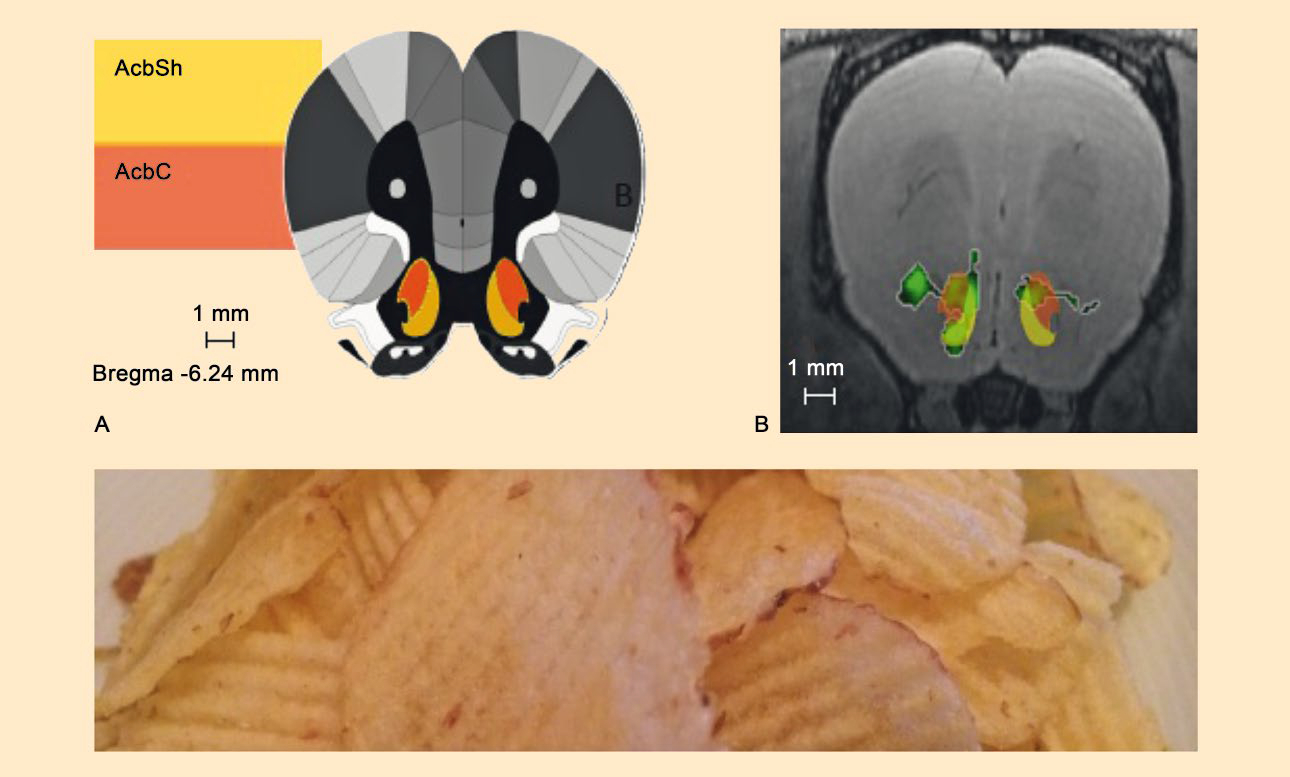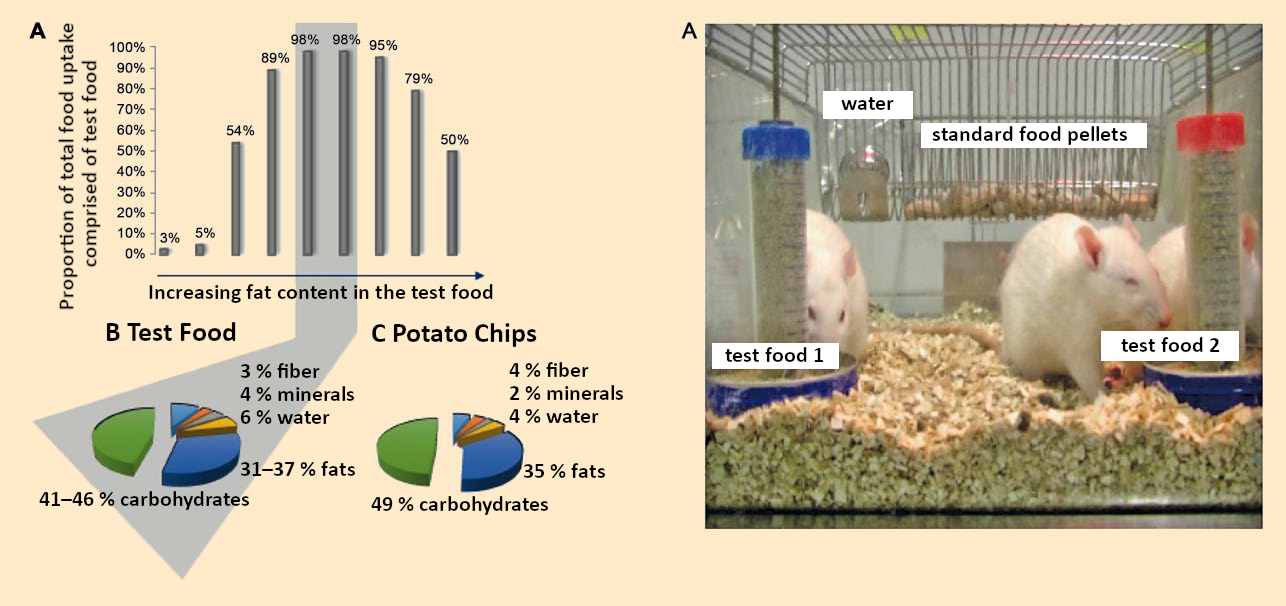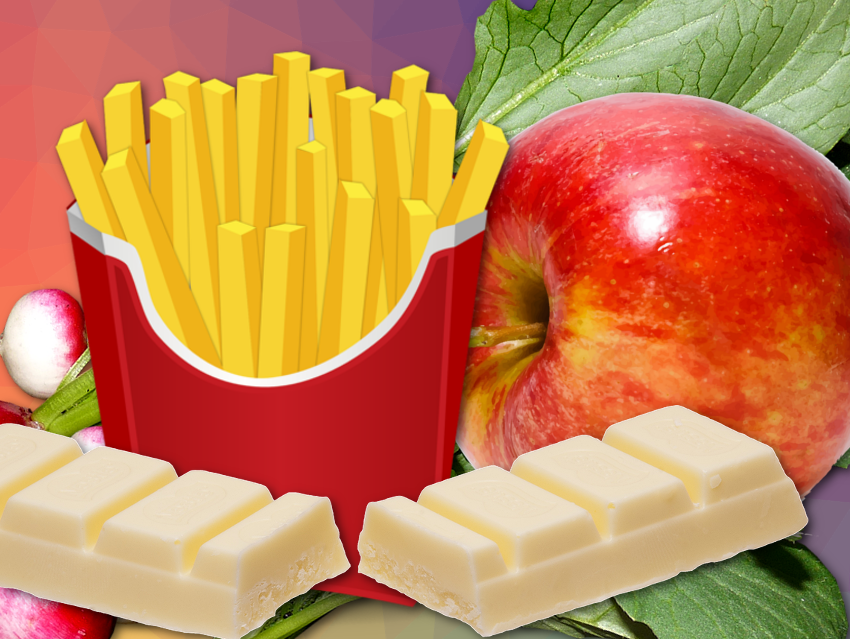Molecular nutrition physiology is concerned with the question of what effects food ingredients can have over specific bodily functions, above and beyond the provision of energy and nutrients. In contrast to other disciplines, it does not focus on the effects of different forms of nutrition or foods. Instead, the goal is to assign a specific physiological activity to a molecularly defined compound.
In this part, we look at which food components might modify brain activity patterns and induce compulsive eating.
5. Losing Control When Eating Potato Chips and Chocolate—What is Happening?
Many consumers experience a loss of control when eating potato chips—a compulsive food intake. When rats are given potato chips in addition to their normal food over a weeklong period while a control group is offered standard food, subsequent MEMRI measurements (see Part 1, Chapter 4) show clear differences between the brain activity patterns of the two groups (see Fig. 4).
In the rats who were offered potato chips, significant changes are seen in ten brain areas that are associated with food intake and satiation, as well as 27 regions involved with reward and addictive behavior. The largest potato-chip-induced increase in activity was found in the nucleus accumbens, a brain region that is often called the “reward center” and that is also activated upon the intake of various addictive substances.
 |
|
Figure 4. Relative to standard food, ingestion of potato chips leads to up to a 15-fold activation of some regions of the nucleus accumbens, a region of the brain that plays an important role in the reward system; A: Position of the nucleus accumbens in the brain (shell (AcbSh) and core (AcbC) of the nucleus accumbens); B: Activation of the nucleus accumbens after ingestion of potato chips can be shown in the brains of rats through special magnetic resonance imaging processes (in this case, MEMRI). |
These studies lead to the conclusion that the intake of potato chips changes brain activity in rats in a way that results in a strong reward signal. This triggers behavior that leads to a non-homeostatic intake of food, i.e., taking in more energy than is necessary to satisfy hunger. This behavior is additionally reinforced by the deactivation of the satiety centers. In humans, such mechanisms could lead to compulsive eating that can only be controlled through cortical, or conscious, processes [11].
5.1. Proportion of Carbohydrates and Fat
Why potato chips and chocolate but not broccoli and brussels sprouts?
In order to trace the effect of a food back to defined molecular components, potato chips were virtually decomposed into their components. How strongly the individual ingredients trigger increased food intake was measured in a two-choice preference test in rats (see Fig. 5) [12]. It demonstrated that non-homeostatic eating similar to that caused by potato chips can be triggered to an equal extent by test food that contains the same proportions of fat and carbohydrate as the chips.
 |
|
Figure 5. A: Two-choice preference test, by which food uptake in relation to the fat and carbohydrate content of the test food can be quantified; B: Molecular composition of the test food that induced the highest food uptake; C: Molecular composition of potato chips. |
It is often stated that life forms, including humans, are programmed for the intake of high-calorie foods. It was, therefore, concluded that the loss of control when eating chips can be explained by their calorie content. However, recent studies showed no direct correlation between caloric content and food intake. The foods with the highest calorie content, those that consist primarily of fat, did not lead to the highest level of food intake at all. Instead, there is clearly an optimal ratio of carbohydrates to fat (40–45 %:32–37 %) that induces the rats to eat [13].
The extent to which these results can be applied to humans remains to be seen. However, the results agree with observations in humans that the highest calorie foods (such as pure fat) elicit disgust rather than appetite. In contrast, ratios of 40–45 % carbohydrates to 32–37 % fat are found in those foods whose consumption we find difficult to control, such as potato chips, peanut flips, or chocolate.
Unlike rats, humans would not be satisfied with a simple mixture of fats and carbohydrates. Neuroscientists like Kent Berridge at the University of Michigan, Ann Arbor, USA, divide the drive to eat into “wanting” and “liking” components [14]. From this hypothesis, we could infer that for humans, the “wanting” that is driven by factors like the fat/carbohydrate composition is not sufficient to trigger eating behavior; liking must also be included. Liking is primarily determined by the sensory properties of the food. In any case, this example clearly shows that in order to understand the interplay between foods and brain function, it is not only important to scientifically examine the physiological processes. It is just as important to investigate the composition of foods to understand the molecular causes of observed nutritional physiological effects.
5.2. The Influence of Other Sensory Stimuli
What is it that controls “liking” a food in humans?
The initial response to this question is usually the general concept of “flavor”, which includes various sensory impressions experienced when eating food, such as aroma, taste, texture, and other chemosensory sensations. These chemosensory stimuli can include burning, stinging, pungency, or cooling effects, such as those caused by capsaicin (which is found in various types of peppers), menthol, or eucalyptus oil.
Humans have a multisensory detector system that uses a variety of sensory modes to obtain information about their environment, in this case, food. We then integrate and interpret this information into an overall concept and react to our overall interpretation of these data through our choice of food or eating behavior. This process has a strong genetic and evolutionary component: Foods induce a positive reaction when they have sensorially recognizable important nutrients like sugar and fat. However, a lifetime of learning is just as important for increasing acceptance of foods as well as for aversion, if we learn that a specific aroma is attached to a bad experience like food poisoning.
Feedback Mechanism
In this case, conditioning, whether positive or negative, is a significant factor, as was impressively demonstrated in young children by Andrea Maier at the Nestlé Research Center, Lausanne, Switzerland [15]. In this study, children were first repeatedly offered disliked vegetables, specifically broccoli, over a period of eight days. The amount of broccoli eaten, and thus, the acceptance of this food, increased continually throughout the experiment. In addition, a positive effect was achieved when the initially disliked vegetable was paired with a sensorially pleasing stimulus—in this case, sugar [16].
It is possible that inborn resistance tied to the alarm signal of “bitter” or fundamental neophobia—an inborn fear of the unknown and possibly toxic—can be overcome or at least reduced by coupling with positive stimuli or by experience through repeated exposure. Individual genetic disposition plays an important role here, because not all people experience chemosensorially active substances in the same way. Senses of smell and taste can vary dramatically in sensitivity, which is expressed with particular emphasis for bitterness. It has been demonstrated that the genetic predisposition for certain bitterness receptors is directly related to sensitivity to the bitterness of some substances [17]. Accordingly, some foods like broccoli are found to be unbearably bitter by some people, and not by others.
Whether an adverse reaction in highly sensitive people can be overcome by positive conditioning is questionable. However, it is not possible to conclude that certain people generally have higher or lower sensitivity to bitterness, because each person has many bitterness receptors that react to a wide variety of bitter substances in a wide variety of substance classes. It is, thus, possible for a “non-taster” of the bitter taste of broccoli to be very sensitive to certain bitter products of the Maillard reaction, the browning reaction observed in the frying and roasting of foods.
The Olfactory Process
When studying the food sensory system, it is extremely important to understand these types of individual differences on both the molecular and physiological levels. The individuality of sensory perception processes also extends to many other areas. For example, it is possible for people with anosmia, i.e., the full or partial absence of the sense of smell, or weak senses of smell, to have very different experiences.
It is assumed that affected persons are lacking the genetic coding for certain olfactory receptors. However, newer research shows that the olfactory process can be significantly more complex. It is becoming increasingly clear that so-called perireceptor events—upstream events like the enzymatic conversion of volatile compounds—can take place in the nose. It is, thus, possible that the substances perceived by the olfactory receptors were not originally present in the same form in the original aroma but were produced as metabolites and then smelled in this form [18]. Such conversion processes can in turn also differ widely between individuals, with the result that a specific aroma is not only perceived with different olfactory impressions by different people, but the intensity can vary as well. It is also interesting to compare this to the neurotropic processes discussed above.
This demonstrates that it may be essential to first observe possible metabolic processes in the body to then draw conclusions about the effects of food ingredients on humans. Differences in olfactory sensitivity do not only apply to the positive side of food aromas but can also be relevant to off-flavors. Unpleasant substances that turn up repeatedly include extremely potent halogenated aromatic compounds. A well-known example of this is 2,4,6-trichloroanisole, which is associated with cork taint in wines. Equally strong odors are perceived for 2-iodophenol and 2-iodo-4-methylphenol, two compounds associated with medicinal smells in mineral water [19].
Interestingly, there is a high rate of anosmia toward these potent compounds, meaning that the medicinal odor they cause is intense and even unbearable for some people, while others do not perceive it at all. The warning function of the olfactory and taste system does not work identically well in all people, at least not for all substances. The same can be true of the intensity and attractiveness of pleasant smelling and tasting substances. The relationships between perception and acceptance or even preference are, thus, very complex, making the influence of aromas and flavors on eating behavior difficult to predict.
Which smell and taste impressions of foods control consumer behavior requires further, more extensive research as it becomes increasingly clear that there is not “a” behavior, but that the diversity of humans also represents a diversity of consumers who are all regulated by different physiological and psychological principles.
References
[11] T. Hoch et al., Manganese-Enhanced Magnetic Resonance Imaging for Mapping of Whole Brain Activity Patterns Associated with the Intake of Snack Food in Ad Libitum Fed Rats, PloS one 2013, 8, e55354. https://doi.org/10.1371/journal.pone.0055354
[12] T. Hoch et al., Snack food intake in ad libitum fed rats is triggered by the combination of fat and carbohydrates, Front. Psychol. 2014, 5, 250. https://doi.org/10.3389/fpsyg.2014.00250
[13] T. Hoch et al., Fat/carbohydrate ratio but not energy density determines snack food intake and activates brain reward areas, Sci. Rep. 2015, 5, 10041. https://doi.org/10.1038/srep10041
[14] K. C. Berridge et al., Dissecting components of reward: ‘liking’, ‘wanting’, and learning, Curr. Opin. Pharmacol. 2009, 9, 65–73. https://doi.org/10.1016/j.coph.2008.12.014
[15] A. Maier et al., Food-related sensory experience from birth through weaning: contrasted patterns in two nearby European regions, Food Qual. Prefer. 2007, 18, 1023–1032. https://doi.org/10.1016/j.appet.2007.02.007
[16] E. D. Capaldi, G. J. Privitera, Decreasing dislike for sour and bitter in children and adults, Appetite 2008, 50, 139–145. https://doi.org/10.1016/j.appet.2007.06.008
[17] D. R. Reed et al., Diverse tastes: Genetics of sweet and bitter perception, Physiol. Behav. 2006, 88, 215–226. https://doi.org/10.1016/j.physbeh.2006.05.033
[18] B. Schilling, Springer Handbook of Odor (Ed.: A. Buettner), Springer International Publishing, Cham, CH, 2017, pp. 73–74. ISBN: 978-3-319-26932-0
[19] A. Strube et al., Identification of a medicinal off-flavour in mineral water, Water Res. 2009, 43, 5216–5224. https://doi.org/10.1016/j.watres.2009.08.026
The Authors
 Monika Pischetsrieder studied food chemistry at the Ludwig Maximillian University (LMU), Munich, Germany, where she also received her doctorate. She completed post-doctoral research at Case Western Reserve University, Cleveland, OH, USA. She habilitated at LMU and served as a Visiting Assistant Professor at Columbia University, New York, USA.
Monika Pischetsrieder studied food chemistry at the Ludwig Maximillian University (LMU), Munich, Germany, where she also received her doctorate. She completed post-doctoral research at Case Western Reserve University, Cleveland, OH, USA. She habilitated at LMU and served as a Visiting Assistant Professor at Columbia University, New York, USA.
Since 1999, she has been a Professor of Food Chemistry and since 2004 has held the Henriette Schmidt-Burkhart Chair for Food Chemistry at the Friedrich-Alexander University Erlangen-Nürnberg, Germany. Monika Pischetsrieder is currently the Chair of the Food Chemical Society of the GDCh (German Chemical Society), as well as a member of the Scientific Advisory Committee of the Federal Ministry of Food and Agriculture.
 Andrea Büttner studied food chemistry at the Ludwig Maximillian University (LMU), Munich, Germany, and received her doctorate and habilitated at the Technical University of Munich and the Research Association of the German Food Industry (DFA) in Freising, Germany. Since 2012, she has been a Professor of Aroma Research and since 2017, has served as the Chair for Aroma and Smell Research at the Friedrich-Alexander University in Erlangen-Nürnberg. In addition, she is Deputy Head of the Fraunhofer Institute for Process Engineering and Packaging in Freising. She also leads the Sensory Analytics Division of the GDCh.
Andrea Büttner studied food chemistry at the Ludwig Maximillian University (LMU), Munich, Germany, and received her doctorate and habilitated at the Technical University of Munich and the Research Association of the German Food Industry (DFA) in Freising, Germany. Since 2012, she has been a Professor of Aroma Research and since 2017, has served as the Chair for Aroma and Smell Research at the Friedrich-Alexander University in Erlangen-Nürnberg. In addition, she is Deputy Head of the Fraunhofer Institute for Process Engineering and Packaging in Freising. She also leads the Sensory Analytics Division of the GDCh.
Contact Address
Monika Pischetsrieder
Friedrich-Alexander-Universität Erlangen Nürnberg (FAU)
Lehrstuhl für Lebensmittelchemie
Nikolaus-Fiebiger Str. 10
91058 Erlangen, Germany
E-Mail: [email protected]
The article has been published in German as:
- Neurotrition – wie Lebensmittel auf die Gehirnfunktion wirken,
Sümeyye Sahin, Andrea Buettner, Monika Pischetsrieder,
Chem. unserer Zeit 2019, 53, 320–328.
https://doi.org/10.1002/ciuz.201900832
and was translated by Caroll Pohl-Ferry.
How Foods Affect Brain Function – Part 1
How food components interact with the GABA type A receptor and the search for neuroactive food ingredients
See similar articles published on ChemistryViews.org




